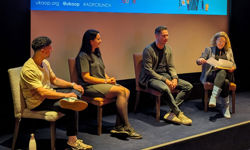Most of us are aware of the problem. Newspapers are read for around 30 minutes a day, around 20 days a month. Newspaper websites are read for 4.4 minutes only 8.4 times a month. Personally I find navigating newspaper websites a painful, non-conducive or satisfying experience. And I have plenty of experience, and a need to read.
So let me draw on some experience from the past.
15 years ago, as colour printing was increasingly being adopted, I was asked to measure the benefit that colour would have over mono (black and white) advertising. As is common in my research, I adopted a dual measurement approach. We utilised eye-movement cameras, to track the differences in what people read in colour and mono. We also interviewed the research participants to determine what they recalled.
To our initial horror, the results did not specifically correlate. I feared that I had wasted my client’s investment. But further analysis revealed that participants were recalling ads that they had seen in their peripheral vision, but had not been picked up by the highly precise eye-movement camera.
The lesson is important in terms of understanding reading navigation. The eye absorbs the headlines of a newspaper page in a fraction of a second, before the brain decides what to focus on. An advertisement has to work in about 0.35 of a second. But once engaged, readers are prepared to spend time with content – stories or advertising – if the message is compelling.
Here is a strange thing that I learned during this project. The eye instinctively looks down, not up. Why? Because over thousands of years, we have been programmed to look at where we are walking before we look to the sky (Here in France, this is particularly important to avoid the dog pooh, but that’s another point!). So I was not surprised when not long after this research project, Microsoft moved many of their buttons to the bottom of the screen, and Apple’s Dock followed.
Another thing I recall is the importance of typography. A study that I undertook in the 80s showed that a difference in standard typefaces, could affect readability, reading fatigue, and advertising recall by around 200%. Hence the emergence of Verdana and Georgia as screen type faces. They pixilate better, but require more space.
An old friend of mine, Donald Grant, once said that: “the newspaper is a formatted set of surprises”. It’s a great description of the beauty of the newspaper medium. Unfortunately it does not currently translate into the digital form. We may have realised the scientific implications of viewing behaviour, but have not as yet translated this into a meaningful navigation system for online content.
The problem is compounded by the fact that Search remains linear rather than intuitive. I can search a subject, but then have difficulty sub searching. I can personalise, but I cannot scan my content needs, in the way that the eye, and subconscious can.
A solution to these conundrums is the route to solving newspapers’ problems with high levels of traffic and no levels of audience intensity.
As eReaders evolve, we need to be far more scientific in our understanding of reading behaviour. Sadly there is very little research on this, but three initiatives will drive our future:
* First is a clearer understanding of how online users navigate their media, visually. We have lost the print experience, and it has not been replicated in the digital space.
* Secondly, content consumption requires a Search 2.0, which is a combination of serendipity and personal experience. I have been predicting for a while that Google Search is at the peak of its product life cycle. We are awaiting the next generation of intuition.
* Third is a greater understanding of the wider level of newspaper consumption. In the USA, newspaper online users may account for 57% of all internet users, but they account for only 1.6% of pages per visitor and 0.9% of total pages visited. So much for being the content medium!
Such research is essential for our industry. Analysis suggests that while patterns vary from title to title and country to country, the lessons are the same. We do not have the same understanding of screen reader experience as we have of print.
But if newspapers are to make the strides in the digital world, that we originally anticipated, but are not achieving, investment into understanding why our digital sites are not delivering the levels we deserve is a small price to pay.
Cheque books out my friends.










